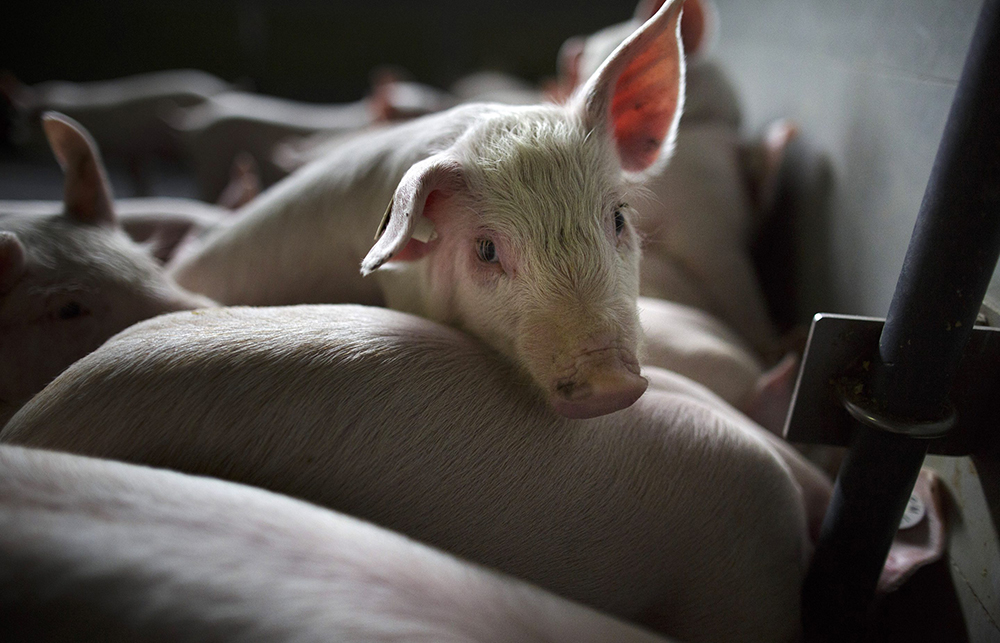
多年以来,如何控制甲烷排放一直是畜牧业所关注的一大问题,而随着第26届联合国气候变化大会(COP26)的逐步推进,相关讨论也很自然地转移到了这一问题上来。但当控制甲烷排放成为气候问题的焦点时,我们必须确保在对话中发出正确的声音,从而找到具有影响力的解决方案。
美国总统乔·拜登提出的“全球甲烷承诺”(Global Methane Pledge)是让农场主参与到监管对话中的绝佳机会,截至目前,已经有100多个国家签署了该承诺。农场主可以为相关问题的解决提供极富价值的意见和见解。借助他们的经验和贡献,我们将能够在制订紧急气候解决方案的同时,继续养活这个世界,在二者之间达到平衡。
只需要将牲畜的甲烷排放量减少三分之一,就可以减缓全球变暖的整体速度,产生降温效应,同时让世界获得更多时间来应对更为复杂、影响更为长久的二氧化碳问题。如果没有农场主、牧场主和土地所有者参与气候变化相关对话,我们就将无法提出可行的解决方案。
在今年一项覆盖1000多名受访者的调查中,礼蓝动保(Elanco)发现,每5名素食者中就有2人认为畜牧业是美国温室气体的最大来源,相信其温室气体排放量多过其他任何行业,但这种认识其实并不正确。
联合国政府间气候变化专门委员会(IPCC)指出,家畜产生的温室气体排放量仅占美国温室气体排放量的4%,而其他单一行业的排放量占比可达75%。许多人没有意识到的是,畜牧业已经在减少自己的环境足迹。
根据联合国粮食及农业组织(Food and Agriculture Organization of the United Nations)的数据,从1961年到2017年,生产牛肉、牛奶、鸡肉、鸡蛋和猪肉造成的温室气体全球平均排放强度分别下降了30%到60%。
畜牧业已经为迎接更大规模的持续性变革做好了准备,但我们必须得到科学的引导,相关法律法规的制订也需要考虑到管理土地的农场主、牧场主和林场主的实际情况。因为养活世界和气候降温二者之间密切相关。
2020年,全球有超过30%的人口无法确保全年都能够获得充足的食物。根据美国农业部(U.S. Department of Agriculture)的数据,贫穷国家有9.21亿人口的粮食缺乏保障,较新冠疫情爆发前增加了1.6亿人。此前,工业化国家曾经承诺通过为新兴经济体提供财政支持、对援助和弹性措施进行投资来改变缺粮现状,但他们却未能达成自己的目标,这也是第26届联合国气候变化大会召开期间的一个主要争议点。
为避免对环境造成额外压力,我们必须以可持续的方式来满足(全球人口的)蛋白质需求。我们必须抓住机会,通过畜牧业创新在肉类生产中实现气候中性,而不是以牺牲全球粮食安全为代价。
从业者可以做些什么
为共同应对气候变化和全球饥饿问题,农场主、牧场主和土地所有者主要关注四大问题:
实施衡量系统,将可持续性纳入日常运营与业务决策。
鼓励创新,推动研发甲烷捕获、转化等新技术。
为农场主创造从可持续经营实践中获益的市场和机会。
与农场主、牧场主和土地所有者进行沟通,帮助他们了解气候中立的可能性,使其明白行业协作是实现相关目标的必要条件。
我们必须倾听土地管理者的声音。满足人类的营养需求、遏制气候变化和实现经济可持续发展都是迫在眉睫且相互关联的全球性挑战,动物能够也必将成为相关解决方案的关键内容。现在正是真正落实“从农场到餐桌”的最佳时机,让畜牧业专家可以把自己的专业知识带到相关的全球对话之中,让我们能够成功合作,带来变革。(财富中文网)
本文作者杰夫·西蒙斯是礼蓝动保(Elanco Animal Health)的总裁兼首席执行官。礼蓝动保是全球动物保护领域的领导者,该组织致力于提升动物、人类和地球的健康水平。
译者:梁宇
审校:夏林
多年以来,如何控制甲烷排放一直是畜牧业所关注的一大问题,而随着第26届联合国气候变化大会(COP26)的逐步推进,相关讨论也很自然地转移到了这一问题上来。但当控制甲烷排放成为气候问题的焦点时,我们必须确保在对话中发出正确的声音,从而找到具有影响力的解决方案。
美国总统乔·拜登提出的“全球甲烷承诺”(Global Methane Pledge)是让农场主参与到监管对话中的绝佳机会,截至目前,已经有100多个国家签署了该承诺。农场主可以为相关问题的解决提供极富价值的意见和见解。借助他们的经验和贡献,我们将能够在制订紧急气候解决方案的同时,继续养活这个世界,在二者之间达到平衡。
只需要将牲畜的甲烷排放量减少三分之一,就可以减缓全球变暖的整体速度,产生降温效应,同时让世界获得更多时间来应对更为复杂、影响更为长久的二氧化碳问题。如果没有农场主、牧场主和土地所有者参与气候变化相关对话,我们就将无法提出可行的解决方案。
在今年一项覆盖1000多名受访者的调查中,礼蓝动保(Elanco)发现,每5名素食者中就有2人认为畜牧业是美国温室气体的最大来源,相信其温室气体排放量多过其他任何行业,但这种认识其实并不正确。
联合国政府间气候变化专门委员会(IPCC)指出,家畜产生的温室气体排放量仅占美国温室气体排放量的4%,而其他单一行业的排放量占比可达75%。许多人没有意识到的是,畜牧业已经在减少自己的环境足迹。
根据联合国粮食及农业组织(Food and Agriculture Organization of the United Nations)的数据,从1961年到2017年,生产牛肉、牛奶、鸡肉、鸡蛋和猪肉造成的温室气体全球平均排放强度分别下降了30%到60%。
畜牧业已经为迎接更大规模的持续性变革做好了准备,但我们必须得到科学的引导,相关法律法规的制订也需要考虑到管理土地的农场主、牧场主和林场主的实际情况。因为养活世界和气候降温二者之间密切相关。
2020年,全球有超过30%的人口无法确保全年都能够获得充足的食物。根据美国农业部(U.S. Department of Agriculture)的数据,贫穷国家有9.21亿人口的粮食缺乏保障,较新冠疫情爆发前增加了1.6亿人。此前,工业化国家曾经承诺通过为新兴经济体提供财政支持、对援助和弹性措施进行投资来改变缺粮现状,但他们却未能达成自己的目标,这也是第26届联合国气候变化大会召开期间的一个主要争议点。
为避免对环境造成额外压力,我们必须以可持续的方式来满足(全球人口的)蛋白质需求。我们必须抓住机会,通过畜牧业创新在肉类生产中实现气候中性,而不是以牺牲全球粮食安全为代价。
从业者可以做些什么
为共同应对气候变化和全球饥饿问题,农场主、牧场主和土地所有者主要关注四大问题:
实施衡量系统,将可持续性纳入日常运营与业务决策。
鼓励创新,推动研发甲烷捕获、转化等新技术。
为农场主创造从可持续经营实践中获益的市场和机会。
与农场主、牧场主和土地所有者进行沟通,帮助他们了解气候中立的可能性,使其明白行业协作是实现相关目标的必要条件。
我们必须倾听土地管理者的声音。满足人类的营养需求、遏制气候变化和实现经济可持续发展都是迫在眉睫且相互关联的全球性挑战,动物能够也必将成为相关解决方案的关键内容。现在正是真正落实“从农场到餐桌”的最佳时机,让畜牧业专家可以把自己的专业知识带到相关的全球对话之中,让我们能够成功合作,带来变革。(财富中文网)
本文作者杰夫·西蒙斯是礼蓝动保(Elanco Animal Health)的总裁兼首席执行官。礼蓝动保是全球动物保护领域的领导者,该组织致力于提升动物、人类和地球的健康水平。
译者:梁宇
审校:夏林
As the United Nations Climate Change Conference (COP26) unfolded, the conversation on climate rightfully shifted to where animal agriculture has been focused for years: combating methane. But as we put methane in the climate crosshairs, we must ensure we are bringing the right voices to the table to identify impactful solutions.
U. S. President Joe Biden’s Global Methane Pledge, now signed by more than 100 countries, is a perfect opportunity to include farmers in conversations about regulation. Farmers bring critical insight to the problem-solving process. Their experience and input will help us thread the needle to enact urgent climate solutions while continuing to feed the world.
Curbing livestock methane emissions by just a third can slow the overall rate of warming, creating a cooling effect while allowing the world more time to address the more complex and long-term CO2 impacts. Without farmers, ranchers, and landowners at the table in climate change conversations, we can’t bring forward feasible solutions.
This year, in a survey of over 1,000 participants, Elanco found that two out of five people who avoid consuming meat believe animal agriculture is the biggest creator of greenhouse gases (GHG) in the U.S., contributing more than any other industry—but that’s wrong.
The Intergovernmental Panel on Climate Change (IPCC) of the United Nations states that livestock generates 4% of U.S. GHG emissions, whereas other singular industries can represent up to 75%. What many don’t realize is that animal agriculture already has a track record of reducing its environmental footprint.
According to data from the Food and Agriculture Organization of the United Nations (FAO), the global average GHG emission intensities for beef, milk, chicken, eggs, and pork have all declined between 30% and 60% from 1961 to 2017.
The animal agriculture industry is poised to usher in continued and greater changes, but science must guide us, and we need regulations that consider the farmers, ranchers, and foresters who steward our land. Because feeding the world and cooling the climate are interconnected issues.
In 2020, more than 30% of the global population lacked year-round access to adequate food. And according to the U.S. Department of Agriculture (USDA), 921 million people in the world’s poorer countries are food insecure—an increase of 160 million since the COVID-19 pandemic began. Industrialized nations that previously committed to changing this through financial support of emerging economies and investment in aid and resiliency measures are missing their targets—a major point of contention during COP26.
Protein demand must be met in a sustainable way to avoid additional strain on the environment. We must seize the opportunity to achieve climate-neutral meat production through innovation in animal agriculture, not at the expense of global food security.
What we can do
Together, farmers, ranchers, and landowners are focusing on four areas to join the efforts against climate change and world hunger:
Implement measurement systems to integrate sustainability into daily operations and business decisions.
Encourage innovation and the discovery of new technologies like methane capture and conversion.
Create a market and opportunity for farmers to benefit economically from sustainable business practices.
Communicate with farmers, ranchers, and landowners to help them understand that climate neutrality is possible, and that industry collaboration is a necessity to reach these goals.
We must listen to those who steward the land. Nutrition, climate, and economic sustainability are urgent, interconnected global challenges, and animals can and will be a critical part of the solution. It’s time for a true “farm to table” approach where animal agriculture experts can bring their expertise to these global conversations so we can successfully collaborate to make a difference.
Jeff Simmons is president and CEO of Elanco Animal Health, a global leader in animal health dedicated to advancing the health of animals, people, and the planet.






